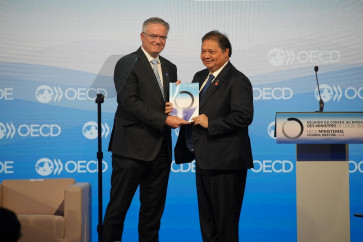Popular Reads
Top Results
Can't find what you're looking for?
View all search resultsPopular Reads
Top Results
Can't find what you're looking for?
View all search resultsIndonesian gamers form lucrative market for advertisers
The growing number of mobile gamers in Indonesia, thought to be around 60 million and estimated to grow to over to 100 million by 2020, will form a juicy target for advertisers in the years to come, according to marketing firms
Change text size
Gift Premium Articles
to Anyone
T
he growing number of mobile gamers in Indonesia, thought to be around 60 million and estimated to grow to over to 100 million by 2020, will form a juicy target for advertisers in the years to come, according to marketing firms.
Mumbai-based mobile-advertising platform Pokkt and Columbia-based marketing consultancy Decision Lab collected the data from July to August this year.
The data show that gamers play an average of 52 minutes per session and 68 percent of them play several times a day. Video games dominate their screen time, with 25 percent, while 17 percent of screen time is used for social media and 12 percent for video streaming.
Of interest to businesses, “the more time a consumer spends on an app, the higher the app’s brand value,” Decision Lab founder Aske Ostergard said at a press briefing about the data on Wednesday.
Regarding in-game advertising media, 25 percent of gamers said they enjoyed video ads, 20 percent interactive ads and 15 percent static ads.
However, the enjoyment level of each of the three mediums “goes through the ceiling” to 37 percent, 32 percent and 33 percent, respectively, when an ad is supplemented with a reward, such as a complimentary level-up or extra in-game credits.
“I don’t think you’d find any other advertising medium where almost 40 percent of consumers are delighted with ads,” said Ostergard.
Rewarded ads worked because users perceived a real exchange of value in watching the ad instead of perceiving it as an intrusion of personal space, he said.
The data also shows the diversity of Indonesia’s mobile gaming community. According to the data, 58 percent of all females — compared to 55 percent of males — play mobile games. Of the male and female gamers, 46 percent are above 35 years old and 54 percent play while they are waiting in, among other places, traffic and public transport.
Ostergard said the findings upended the stereotype that Indonesian gamers were predominantly game-dedicated teenage boys and the fact, therefore, opened up other demographic segments to mobile advertisers.
He added most gamers played between 7 p.m. and 10 p.m. every day.
Pokkt Asia-Pacific vice president Pravin Shetty said for the two marketing firms, what stood out most from the data was that as many as 54 percent of Indonesian mothers play mobile games.
The fixation on mothers is justifiable because, in marketing, mothers are a money-making demographic segment and are seen as trend setters in household commodity consumption. If a mother, for example, is convinced to use a particular brand of toothpaste, her family will likely follow suit.
Pravin said the high engagement of mothers was possible because mobile devices offered more casual games compared to consoles and desktop computers, which offered more hardcore games.
These trends, albeit newly recorded in Indonesia, were similar to other mobile-gaming countries according to the chief executive officer of the New-York based Mobile Marketing Association (MMA), Greg Stuart.
Stuart said, on a global average, mobile games were predominantly played by middle-aged women, were mostly played by users in idle time and constituted 40 to 50 percent of screentime.
Ideas of “I’m bored, what can I do?” or “the device is readily available and capable of giving entertainment” might be the driving factors of people to play mobile games, he said.
He added that MMA research confirmed that rewarded video advertising was the “best performing” marketing channel in terms of advertising impact.
“It’s really hot,” he said. (nor)










